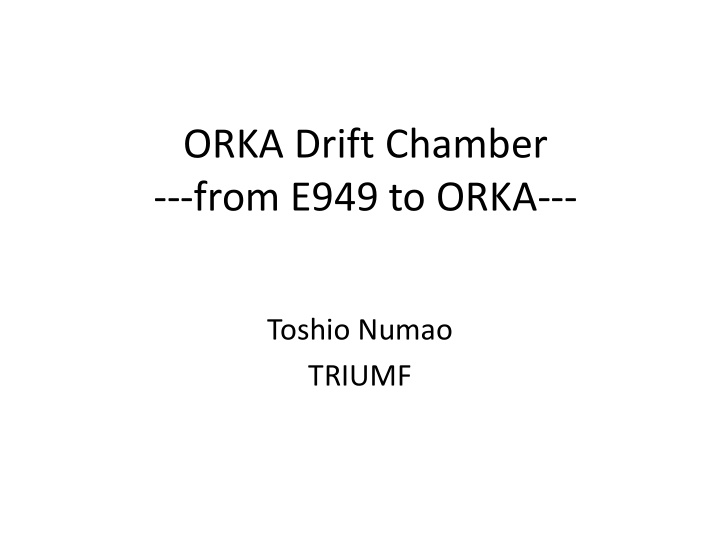



ORKA Drift Chamber ---from E949 to ORKA--- Toshio Numao TRIUMF
Requirements -Single track with p=100-250 MeV/c -R/P, P/E for particle ID -Define P acceptance by P+ ∆ Tg -Detect extra tracks Improvements over E949 - ∆ p = 0.9*E949 -Dip angle up to ± 45 degrees. -Rate = E949 * 10 (may be 3)
E949 DC Design Principle Learned from E787 chamber (5-Super-Layer JET chamber) - Limited by MS - Stereo Super Layers (2,4) poor z-resolution ( σ =2.5 mm) - Additional inner wire chamber Inner region available 10 % improvement in ∆ P - 3 super layers each with 4 layers. - Fill the gaps with light gas (Ar is a bad gas). - Leave a possibility of He based gas for the active region. - Cathode readout for z-measurement. - No support structure in the middle. (self-supporting foils by differential pressures)
Summary of radiation length Single layer of foil (6-8 mm wide strips) 1mil Mylar 9 x 10-5 2000 A Cu 1.4 x 10-5 Single layer of Al-wire cathode plane 2 100- µ m diameter Al wires / cm 1.8 x 10-5 Single layer of anode plane 1 100- µ m diameter Al wire /cm 0.9 x 10-5 1 20- µ m diameter of W wire /cm 0.4 x 10-5 E949 chamber Total Foils 4 middle foils 0.4 x 10-3 Wires 3 x 4 cathode planes 0.2 x 10-3 4 x 4 anode planes 0.2 x 10-3 Gas 15 cm Ar/Ethan 0.9 x 10-3 16 cn N2 0.4 x 10-3
Mechanical structure End plates: 1.2cm Ultem (inner) 1.2cm Noryl (mid,out) 0.4cm Al Inner cylinder: 0.04 cm G10 Outer cylinder: 0.01cm C-fiber Wire load: 400kg (A:40g, C:100g) Support rods while stringing. Pre-stressed by compression rods. Vertical stringing from inner to outer.
Typical track Anodes: # of hits > 4/SL 99% efficient # of Cathode hits: 2-5 At high rate: less efficient
Space-time relation Drift paths Isochrons Not symmtric at the foil layer.
Resolutions Consistent with MC (2.3) including 1.8 from Target Z-resolution
Improvements toward ORKA Better resolution beyond the higher B-field effect? - Longer path length? Larger OD possible? - He based gas to reduce MS? (Very small improvement by filling the N2 layers with He). - Smaller/hexagonal cells? Thinner super-layers less Ar. - GEM or Si-strip detectors at inner/outer radius? Higher rates - Cathode shaping time is too long. Also, AC coupled DC coupled? Record waveform? - Thinner cathode strips to match the cell size? Better s/n ratio? Longer Chamber - Z-resolution ok? Wire stability? Foil angle? Attenuation? Photon veto - Active end plates? Mixing active material in the endcap?
Range Stack Chamber Located around layers 10 and 14. Provides axial coordinate (wire) and z coordinate. E787 Proportional wire chamber with serpentine cathode strips (delay line). - Efficiency variation - strip-strip cross talk (more direct path) E949 Straw chambers (delay in wire provided Z).
RSSC Operated in self-quenching streamer mode - Large pulse Problems -Position dependent resolution due to attenuation -Nonlinearity -Cross talk effect New amp/discriminator. Resolution = 3 cm. ORKA Wire chamber is Ok, but - 3 cm z-resolution good enough? - Longer chamber more attenuation. - Wire sagging, instability? Other possibilities?
Recommend
More recommend